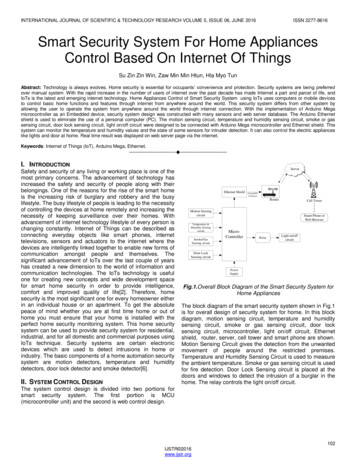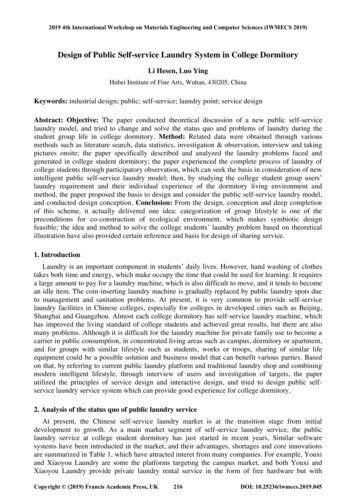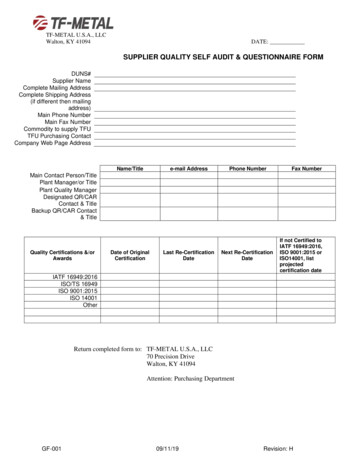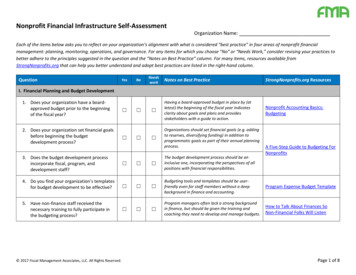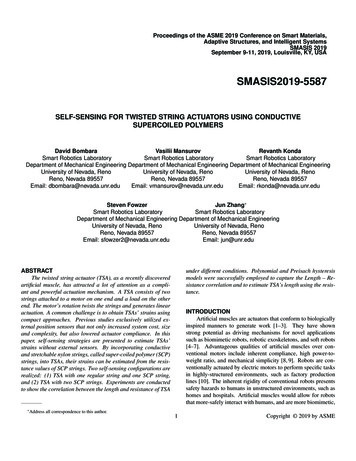
Transcription
Proceedings of the ASME 2019 Conference on Smart Materials,Adaptive Structures, and Intelligent SystemsSMASIS 2019September 9-11, 2019, Louisville, KY, USASMASIS2019-5587SELF-SENSING FOR TWISTED STRING ACTUATORS USING CONDUCTIVESUPERCOILED POLYMERSDavid BombaraVasilii MansurovRevanth KondaSmart Robotics LaboratorySmart Robotics LaboratorySmart Robotics LaboratoryDepartment of Mechanical Engineering Department of Mechanical Engineering Department of Mechanical EngineeringUniversity of Nevada, RenoUniversity of Nevada, RenoUniversity of Nevada, RenoReno, Nevada 89557Reno, Nevada 89557Reno, Nevada 89557Email: dbombara@nevada.unr.eduEmail: vmansurov@nevada.unr.eduEmail: rkonda@nevada.unr.eduJun Zhang Steven FowzerSmart Robotics LaboratorySmart Robotics LaboratoryDepartment of Mechanical Engineering Department of Mechanical EngineeringUniversity of Nevada, RenoUniversity of Nevada, RenoReno, Nevada 89557Reno, Nevada 89557Email: sfowzer2@nevada.unr.eduEmail: jun@unr.eduABSTRACTThe twisted string actuator (TSA), as a recently discoveredartificial muscle, has attracted a lot of attention as a compliant and powerful actuation mechanism. A TSA consists of twostrings attached to a motor on one end and a load on the otherend. The motor’s rotation twists the strings and generates linearactuation. A common challenge is to obtain TSAs’ strains usingcompact approaches. Previous studies exclusively utilized external position sensors that not only increased system cost, sizeand complexity, but also lowered actuator compliance. In thispaper, self-sensing strategies are presented to estimate TSAs’strains without external sensors. By incorporating conductiveand stretchable nylon strings, called super-coiled polymer (SCP)strings, into TSAs, their strains can be estimated from the resistance values of SCP strings. Two self-sensing configurations arerealized: (1) TSA with one regular string and one SCP string,and (2) TSA with two SCP strings. Experiments are conductedto show the correlation between the length and resistance of TSA Addressall correspondence to this author.under different conditions. Polynomial and Preisach hysteresismodels were successfully employed to capture the Length – Resistance correlation and to estimate TSA’s length using the resistance.INTRODUCTIONArtificial muscles are actuators that conform to biologicallyinspired manners to generate work [1–3]. They have shownstrong potential as driving mechanisms for novel applicationssuch as biomimetic robots, robotic exoskeletons, and soft robots[4–7]. Advantageous qualities of artificial muscles over conventional motors include inherent compliance, high power-toweight ratio, and mechanical simplicity [8, 9]. Robots are conventionally actuated by electric motors to perform specific tasksin highly-structured environments, such as factory productionlines [10]. The inherent rigidity of conventional robots presentssafety hazards to humans in unstructured environments, such ashomes and hospitals. Artificial muscles would allow for robotsthat more-safely interact with humans, and are more biomimetic,1Copyright 2019 by ASME
utilize external position sensors – the adoption of external sensors not only increase system cost, size and complexity, but alsolower actuator compliance which is undesirable for applicationslike soft robots, robot exoskeletons, and medical assistive devices.In self-sensing of TSAs, the strain is estimated based on anelectrical signal from the actuator, allowing small-scale and lowmass devices for the robotics applications. Self-sensing for softmaterials have been explored, but those actuators are more difficult to manufacture than TSAs [2]. TSAs are unique in thatthe actuator only consists of two strings connected to a motorwith no strict limitation on the type of strings that can be used.Therefore, the utilization of a conductive material in the TSA canenable self-sensing based on overall resistance change of the actuator during its deformation. Resistance change should be largeenough to be easily detectable, while inconsistencies in manufacturing should have minimal effect on the resistance change.The resistance change in a string will come from the strings’ deformation as it twists by relating cross-sectional area, the length,and the material’s resistivity.Deformation should be elastic, not plastic to allow repeatedactuation cycles. Utilization of a simple wire in the elastic deformation region would create a very small change of the resistance.On other hand, silver-coated nylon can provide a wider rangeof elastic deformation and resistance change. By coiling silvercoated nylon polymer string, the changes in length and resistanceare magnified, making it suitable for self-sensing in TSAs.Being a new technology, super-coiled polymer (SCP) stringshave attracted a lot of attention in both the materials and roboticscommunities [3, 20, 21]. First invented in 2014 [20], SCP stringswere originally developed as thermally-activated artificial muscles that can generate linear actuation under thermal excitation.Under thermal stimuli, which is often realized by electric powerinduced Joule heating, SCP actuators can contract significantly[20, 22, 23]. Conductive and stretchable SCP strings can be efficiently fabricated by coiling conductive nylon polymer threadsor other fibers and filaments, like carbon nanotube yarns, fishinglines, and sewing monofilaments and multifilaments [20, 24, 25].While most of the existing studies employed SCP strings as actuators [26,27], there is a recent interest in adopting SCP strings assensors. In [28], a linear relationship between the resistance andthe length of SCP strings was observed, and it was proposed thatSCP strings could be used as position sensors with application tosoft robots. Abbas and Zhao demonstrated that both the appliedload and change in length of conductive coiled thread can be usedto determine resistance change in SCPs [29]. SCP strings manufactured from graphite power and nylon threads were also usedas position sensors in [30]. It is thus promising to incorporate theSCP strings into TSAs for strain sensing.This paper presents the first study on self-sensing for TSAs.By incorporating conductive and stretchable SCP strings intoTSAs, their strains can be estimated from the resistance values2 mmFIGURE 1. The schematic of a twisted string actuator (TSA) (left). ATSA consists of two braided ultra-high-molecular-weight polyethylenestrings (middle). A contracted TSA in operation (right).lightweight, and low-cost [11, 12]. Artificial muscles are commonly compared to mammalian skeletal muscle on factors suchas efficiency, power density, stroke, and bandwidth [3]. Currently, no artificial muscle exceeds all metrics of biological muscles, but many artificial muscles out-perform natural muscle inone or more aspects [2, 3].The twisted string actuator (TSA) belongs to an emerging artificial muscle technology that can generate linear motions fromthe rotary motion of an electric motor [13, 14]. As shown inFigure 1, a TSA consists of one or more strings connected to amotor on one end and a load on the other end [2]. Although onlyone string is necessary, generally two strings are connected inparallel for quicker actuation [15]. The twisting of the stringsdecreases their length, which displaces the load in a linear direction. TSAs are advantageous over a winch connected to amotor because TSAs can output greater forces with low inputtorque. The TSA has good energy-efficiency and is capable ofexerting more force per cross-sectional area than natural muscle [2]. Furthermore, TSA exhibits good biomimicry and compliance, which comes from the strings resembling long musclefibers that are inherently compliant and achieve 30-40% strainupon actuation [2]. Ultra-high-molecular-weight polyethylene(Dyneema, Vectran and their derivatives) is the most commonlyused string material. Due to these advantages, TSAs have beenutilized in various robotic applications, such as robotic hands,robot exoskeletons, tensegrity robots, and soft robots [16–18].Although TSAs are strong, compliant, and compact, a common challenge is to obtain the contraction of TSAs using compact solutions. One approach is through accurate modeling ofTSAs. Models that relate the strings’ rotations to their changein length have been developed [14, 19]. However, the correlation may change significantly depending on the externally applied load [14]. To know the displacement, one must also knowthe load applied to the strings. Another common approach is to2Copyright 2019 by ASME
RegularstringSCP 12 mm2 mmSCPSCP 2(a)(b)FIGURE 2. (a) The schematic of a TSA consists of a super-coiled polymer (SCP) string and a regular string (left). A TSA consists of one SCP stringand one braided ultra-high-molecular-weight polyethylene string (middle). A contracted TSA in operation (right). (b) The schematic of a TSA consistsof two SCP strings (left). A TSA consists of two SCP strings (middle). A contracted TSA in operation (right).Scheme 2: TSA with Two SCP StringsIn this configuration, two SCP strings replace the normalstrings used in TSAs. With a load attached at the end of thestrings, both SCP strings will be in constant tension. As thestrings twist around themselves, their combined cross sectionalarea will increase, and the length of TSA will thus decrease. Aschematic and the actual TSA configuration are shown in Figure2(b). These changes correlate to a decrease in electrical resistance since the adjacent coils of the SCP strings will be closerand more SCP components will be in contact. An advantage ofthis configuration is that with two same SCP strings to constructthe TSA, the SCP strings will have the same tension, with producing a more stable actuator structure.of SCP strings. Two self-sensing configurations are realized: (1)TSA with one regular string and one SCP string, and (2) TSAwith two SCP strings. A series of experiments are conducted toshow the correlation between the length and resistance of TSAunder different conditions. Polynomial and Preisach hysteresismodels were successfully employed to capture the Length – Resistance correlation and to estimate TSA’s length using the resistance. Furthermore, the advantages and disadvantages of theapproaches are discussed.PROPOSED SELF-SENSING SCHEMESIn this section, two schemes are presented to incorporateSCP strings into TSA: (1) TSA with one regular string and oneSCP string, and (2) TSA with two SCP strings.EXPERIMENTAL SETUPAssembly and Fabrication of TSAs and SCP StringsAssembly of TSAs The essential components of TSAsare an electric motor, two strings, and a load. Any number ofstrings can be used, however, two strings provide a balance ofsimplicity and fast actuation, thus were adopted in this study.One end of the strings is attached to the motor. A load, whichensures the strings remain taut during actuation, is attached tothe free end of the strings. The ends of the strings attached tothe load do not rotate. Twisting the TSA will shorten its lengthand generate a linear motion. The readers are referred to [14] formore information on the assembly of TSAs.Scheme 1: TSA with One Regular String and One SCPStringIn this configuration, the TSA consists of one regular stringand one SCP string. When the two strings twisted about eachother, the SCP string will be twisted around the other normal string. A schematic and the actual TSA configuration areshown in Figure 2(a). For the normal string, braided ultra-highmolecular-weight polyethylene with a diameter of 1.0 mm wasadopted in this study, similar to existing studies [14, 19]. It isnoted that other types of materials can also be used. When thisTSA is twisted, a large linear contraction can be obtained, and theTSA’s resistance change is purely due to the resistance changeof the SCP string. An advantage of this configuration is thatnot only the TSA exhibits resistance change, the incorporationof polyethylene increases the overall strength of the system [31].Fabrication of SCP Strings Following our previousstudy [26], the V Technical Textiles Conductive Yarns (110/34dtex, Denier:110/34f) were used to fabricate SCP strings. Themanufacturing process was comprised of two steps. The firststep was to uniformly coil the conductive nylon threads. In the3Copyright 2019 by ASME
SELF-SENSING MODELING FOR TSATwo mathematical models were adopted to correlate the resistance with the displacement of the load. A brief explanationof these models is presented in the following subsections.MotorPolynomial ModelAlbeit simple, a polynomial model can be adopted to estimate the length of the TSA using its resistance value:TSAMultimeterRulerLlinear (R) p0 p1 R p2 R2 · · · pk RK ,where Llinear denotes the length of the TSA, R is the resistanceof TSA, and K is the order of the polynomial. The polynomialmodel can be efficiently identified using the MATLAB commandpolyfit. With a low order, the computational cost of the polynomial model is low.LoadPower SupplyFIGURE 3.(1)The experimental setup for TSA measurements.Preisach Hysteresis ModelAs a common type of nonlinearity, hysteresis appears in awide variety of materials and structures, such as ferromagneticmaterials, elastic materials, and smart materials [32, 33]. BothSCPs and TSAs exhibit hysteresis in existing studies [11,22,31].It is thus expected that hysteresis may appear by incorporatingSCP strings into TSA.To model hysteresis behaviors, different approaches havebeen adopted. Among the existing models, the Preisach model isone of the most effective and widely used methods. The Preisachmodel can be expressed as a weighted superposition of delayedrelays [32–35]. The identification of the Preisach operator can beefficiently realized by discretizing the weight distribution [33].The discretization level, M, quantifies the computational complexity of the Preisach model. M is commonly chosen between10 and 40.The Preisach model will be used to estimate the length ofthe TSA using its resistance:second step, the coiled thread was double backed on to form astable structure. Sample SCP strings are shown in Figure 2. It’snoted that heat treatment is commonly required to fabricate SCPstrings as actuators. In this study, it’s found that heat treatmenthad negligible effect on their use as sensors, so heat treatmentwas eliminated from the fabrication process.By coiling a different number of nylon threads, SCP stringswith different diameters can be manufactured. In this study, twotypes of SCP strings were fabricated with different thicknesses,one manufactured by using 4-ply nylon threads (referred to as“Thin SCP String”), and the other with 8-ply nylon threads (referred to as “Thick SCP String”). The number of turns andweights used for the coiling process were determined experimentally. More details about the manufacturing of SCP actuators canbe found in [11] and [26].Experimental SetupThe experimental setup was shown in Figure 3. A stepper motor (NEMA 17HS4401) was held vertically by a metallicframe. The TSA was attached between the stepper motor andthe load. Number of turns of the motor were controlled throughan Arduino Mega 2560 micro-controller board and A4988 motorcontroller. The load was attached to a lightweight horizontal barthat provided displacement measurements based on the ruler, andprevented one side of the strings from turning freely. A digitalmultimeter (NKTECH VICI VC480C ) was employed to measure the resistance of the SCP strings with a resolution of 0.01 Ωunder 20 Ω and 0.1 Ω beyond 20 Ω. Depending on the configuration of the TSA, a combination of SCP strings and/or normalstrings of ultra-high-molecular-weight polyethylene were used.M M 1 iLPreisach (R) i 1 µi j si j (R) c0 ,(2)j 1where µi j is the discretized weight to be identified, si j (R) isfully dependent on the resistance value, c0 is a constant bias.The identification of the Preisach model can be reformulatedas a constraint linear least-squares problem and solved with theMATLAB command lsqnonneg. More details about the Preisachmodel can be found in [33, 36–39].4Copyright 2019 by ASME
EXPERIMENTAL RESULTSIn this section, a series of experiments were conducted to obtain the correlation between the resistance and length of TSAs.Two self-sensing schemes were tested, namely (1) TSA withone regular string and one SCP string, and (2) TSA with twoSCP strings. Two types of SCP strings were tested with different thicknesses, namely “Thin SCP String” using 4-ply nylonthreads and “Thick SCP String” using 8-ply nylon threads. Different loading conditions were also tested to evaluate the Length– Resistance correlations. Polynomial and Preisach models wereadopted to capture and estimate the lengths of TSAs using theresistance measurement.to 21 cm, generating over 25% contractions. Two loading conditions were tested, one with 450 g of weight, and the other was550 g. The corresponding Length – Resistance correlation measurements were provided in Figure 4(c). As shown, there wasan evident correlation between resistance and length – the resistance increased with increasing length and very mild hysteresisbehavior was observed. This can be explained as follows: whenthe motor generates fewer number of rotations, the TSA becomeslonger. The distance of the adjacent coils of the SCP string is alsolarger, thus producing a larger resistance value. Under a largerloading condition, the TSA became longer and produced a largerresistance. The results are consistent with existing studies of using SCP strings as sensors [25].Both polynomial model and Preisach model were adoptedto characterize the Length – Resistance relationship of TSAs.With the self-sensing model, the length of TSA, as the output,can be inferred from the resistance value, as the input. Firstly,two third-order polynomial models were identified to capture thehysteresis of TSA under 450 g and 550 g of loading, as shownin Figure 4(d). The corresponding parameters were provided inTable 1 (Scheme 1, Case 1). The modeling error was 0.20 0.12 cm and 0.15 0.13 cm for the TSA under 450 g and 550g loading, respectively (Figure 4(f)). The term “index” refers tothe numbering of the quasi-static strain values, and in total 15data points were taken. Considering that the range of the TSAlength change was over 6 cm, the model can be used to infer theTSA’s length reasonably well using resistance values. Secondly,the identification of the Preisach model was done by reformulating it as a constrained least-squares optimization problem [33].General Procedures and Evaluation MetricsTo measure and capture the relationship between the resistance and length of TSAs, the following procedures were employed. Firstly, the TSA was manufactured either with one SCPstring and one regular string, or with two SCP strings. A weightwas used to generate a constant loading condition for the TSA.Secondly, the motor generates a sequence of rotations to changethe length of TSA. Each rotation was held for 3 minutes, ensuring that the steady-state length and resistance would have beenreached. The correlation between the steady-state length and resistance was obtained based on the measurements. Lastly, mathematical models were adopted to evaluate the self-sensing capabilities – to estimate the TSA length based on its resistance value.The average absolute error and standard deviation were employed to evaluate the modeling performance:NTABLE 1. ei Eaver i 1N,vu Nuu ( ei Eaver )2tσ i 1,N 1Identified parameters of the third-order polynomials.p0p1p2p3Loading (450 g)-386.67547.445-1.8310.024Loading (550 g)-290.98435.355-1.3280.017Loading (700 g)-143.84333.216-2.1000.045Loading (900 g)-77.50118.534-1.0400.020Loading (250 g)-40.54012.630-0.7320.015Loading: (350 g)-81.32520.407-1.2150.025Loading (700 g)-21.36016.661-1.7320.063Loading (900 g)-5.98411.132-1.0340.034(3)Scheme 1, Case 1:(4)Scheme 1, Case 2:where N is the number of data-points to be evaluated and ei denotes the error of
Department of Mechanical Engineering University of Nevada, Reno Reno, Nevada 89557 Email: dbombara@nevada.unr.edu Vasilii Mansurov Smart Robotics Laboratory Department of Mechanical Engineering University of Nevada, Reno Reno, Nevada 89557 Email: vmansurov@nevada.unr.edu Revanth Konda Smart
